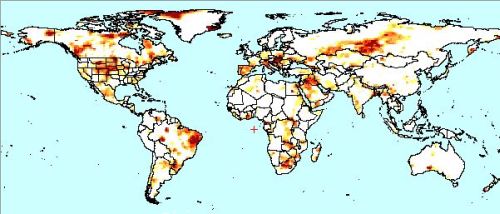
A map of worldwide drought as of February 2013 shows more than 178 million people living under extreme drought.
The darkest red on the map indicates extreme drought over the last twelve months. These areas are experiencing widespread crop and pasture losses; exceptional fire risk; and shortages of water in reservoirs, streams, and wells, creating water emergencies.
The areas experiencing the worst drought are also some of the most productive in terms of food crops for the world or for their region – central United States, eastern Brazil, eastern and southern Europe, and southern Russia.
The difference between this year’s map and last year’s map at this time appears striking. Not nearly as much land in the red, even though only fourteen million fewer people are living under extreme drought.

It’s important to remember that a lessening of a drought doesn’t necessarily bring relief for farmers. Drought kills the plants first, but then destroys the soil. A hard, dry soil doesn’t absorb water as well when the rains do come. Severe enough or long enough droughts ruin soil fertility, which has to be built up again over time.
Water runs off a hard soil and directly into creeks and rivers and ultimately in the ocean, removing topsoil and pollutants, both of which have a negative impact on our water cycle.
For farmers, an extreme drought often reduces or completely wipes out any savings they had set aside for the hard times. When the rains come, even if there is enough good soil to grow crops in, the farmers might not have money to buy the seed.
In other words, the lessening of a drought doesn’t necessarily lessen the problems. There’s still work to be done to restore those areas that have suffered.
Drought maps from the drought monitor of the UCL Department of Space and Climate Physics

You must be logged in to post a comment.